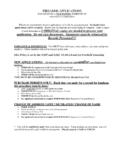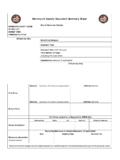Transcription of Freehold Restrictive Covenant Insurance - Legal & …
1 Legal & Contingency Limited 2013 - 1 of 2 - APR13 Freehold Restrictive Covenant Insurance It is assumed that the need to purchase this cover has resulted from the identification of a breach or potential breach of one or more Restrictive covenants. This document is intended to assist in ensuring that you provide us with the relevant and necessary information and documents that we require to consider the availability of a Restrictive Covenant Insurance Policy. In addition, this document is intended to assist you in considering the specific demands and needs your client has in relation to the cover they require from the policy so that you can inform us of these and we can assist in arranging the most appropriate cover. Depending on the circumstances of a risk and the specific Restrictive covenants for which cover required, the provision of a policy can be considered: for developments or changes of use pre-planning for developments or changes of use post planning on a continued use basis ( post development) Please also refer to the policy to understand its full terms and conditions.
2 Required information You should provide a covering e-mail or letter setting out details of the risk. We will need to know: 1. Property Address: the full property address; where there is not a postal address please provide a description, land at London Road, Hertford, together with a suitable plan which may be the filed plan or a site layout/development plan. 2. Level of cover required: the current value of the property (or agreed sale price); if there are proposals to change the use, develop or redevelop the property please also advise the estimated end developed value. See the note on Assessing Your Clients Needs below for assistance. 3. Insured Use: the current use and any proposals to change the use, develop or redevelop the property. 4. Planning Position (if relevant): (a) the current position relating to planning permission for any proposed change the use, development or redevelopment of the property.
3 (b) when cover will be required; pre-planning, post-planning, or post completion of the development. (c) where planning permission has been granted, or cover only required once planning permission has been granted, we will need to be provided with copies of all letters of objection received by the planning authority or any of the parties to the transaction. 5. Restrictive Covenants: the Restrictive covenants for which cover is required. Please provide office copy entries and filed plan for the property and if available a copy of the deed containing the Restrictive covenants. 6. Communications with third parties: full disclosure of any approaches that have been made by the vendors, purchasers or their respective agents and advisers to any party likely to have the benefit of the Restrictive covenants including details of any existing deed of release or ongoing negotiations relating to the Restrictive covenants.
4 7. Disputes and Notices: full disclosure of any disputes or notices relating to the property. 8. Additional information: depending on the risk circumstances the following information may be relevant: (a) previous planning history of the site (pre-planning) (b) details of the publicity given to the proposed development (c) details of any similar developments in the immediate vicinity (d) site layout plan of the proposed development (if available) (e) copies of adjoining and neighbouring titles. Contact Us Legal & Contingency Limited 19-21 Great Tower Street London EC3R 5AR DX: 843 London/City Tel: +44 (0) 20 7397 4343 Legal & Contingency Limited 2013 - 2 of 2 - APR13 What the standard policy covers This policy provides protection from financial loss that might arise in the event of a third party enforcing or attempting to enforce Restrictive covenants that affect the property.
5 The following losses are covered by a standard policy: 1. court ordered damages or compensation 2. demolition, reinstatement or alteration cost of works 3. loss in market value 4. abortive costs of works 5. increased interest payable 6. settlement costs 7. defence costs 8. other costs and expenses incurred with the insurers prior agreement Please refer to the policy for full details. This policy will not cover 1. any use, change or use, development or redevelopment of the property unless it is described in the Insured Use defined in the policy 2. any Restrictive covenants that are not included in the definition of Restrictive Covenant 3. any loss arising from enforcement of any rights of light or air Who is insured Unless otherwise stated in the definition of Insured this policy will provide cover for the owner of the Property named in the policy and their lender and also successors in title to the property or any part of it including mortgagees, lessees and chargees, the benefit of the policy will pass to successive owners of and interests in the property.
6 How long the policy is valid Unless otherwise stated in the definition of Period of Insurance the policy is provided for a term in perpetuity from its commencement date, it does not have an expiry date. Important points that apply to the policy The policy may not provide protection if: the existence of the policy is disclosed to third parties there are communications with third parties in relation to matters cover by the policy where such third party have the benefit of the matter applications are made to any court, the Lands Chamber of the Upper Tribunal or the Land Registry in relation to matters cover by the policy the insured induces a claim by uninsured actions any admission, compromise, offer, promise, payment or indemnity is made without the prior written consent of the Insurer.
7 The maximum amount the insurer will pay is the limit of indemnity shown on the policy. The policy provides financial compensation only for losses as set out in the Cover section of the policy. Other important considerations There may be consequences arising from the enforcement of the Restrictive covenants which are not adequately covered by financial compensation. For example: 1. if the policy is to provide cover for a continuation of an existing use in breach of Restrictive Covenant and the insured has acquired the property specifically to continue that use, the enforcement of Restrictive covenants may result in the insured being unable to use the property as they intended which may mean that they will need to relocate to alternative premises in order to continue their business 2. if there is enforcement of Restrictive covenants against a developer they may not be able to carry out the development that they intended.
8 An Insurance policy cannot guarantee that a settlement can be negotiated with a party who has a valid Legal course of action available to them. The purpose of the policy is not specifically to fund a settlement however the costs of settlement may, depending on the circumstances of a claim, be the most appropriate basis on which a claim is resolved. Assessing Your Clients Needs Where possible we are able to provide bespoke policy solutions which meet your clients Insurance demands and needs. Depending on the nature of your clients proposals for the property and the nature of the transaction, or the business they intend to operate from the property, your client may have exposure to additional losses that are not covered by the standard policy. A client who is acquiring an option over a site prior to submitting a planning application may incur option fees and then subsequently planning fees which may prove abortive if enforcement of the Restrictive covenants is threatened at the planning stage.
9 Some client s may potentially suffer an interruption to their business in the event of enforcement of Restrictive covenants and may require cover for loss of profits, continuing liability to pay rent under the terms of their lease, staff redundancy or relocation costs and other losses consequent upon them being unable to continue their business at the property either temporarily or permanently. If your client is a Freehold investor with the benefit of rental income from leasehold interests in the property, they may suffer a loss of rent receivable from tenants if such tenants are unable to occupy the premises due to enforcement of Restrictive Covenant and are not liable to continue to pay rent. The above are examples of potential additional losses that are not covered by the standard policy but can be considered; there may be others.
10 Consideration should be given the monetary amounts for which cover should be requested in relation to such losses.







